Early Fence Building
By Sidney Perley
Fences often exist today to designate
boundary lines; but in the earliest days of our settlements they
were probably never constructed for that purpose, unless the
three-rail fence erected between the towns of Newbury and
Rowley, in 1649, was such an instance. The earliest fences were
for protection from the Indians and the larger and more
ferocious animals of the forest; the next, to keep both domestic
and wild animals from the cultivated crops of the settlers; and
the later, to restrain the various kinds of cattle of the
settlers from straying into the forest and elsewhere. These
fences were all made for the purposes to which they were
applied, and were often uncouth and rough. Ornamented fences
belong to a still later period, when settlements had acquired
some degree of affluence.
Each farmer had to build and maintain
his fences when they were erected on or around his individual
lots of land; but the common pastures, with their many owners,
early demanded some rule or authority by which the fence around
them would be built and kept in order during the season of
pasturage by all the owners; and in 1633 it was provided that
each owner of a common pasture should build and support such
part of the fence as was in proportion to his interest in the
pasture; certain sections representing such portions being
marked off.
These were usually the early two-railed
fences. Officers were appointed to examine into the case of any
delinquent, with power to levy and collect fines. In 1643, the
regulation of common fences was left wholly to the respective
towns.
The law in relation to fences around
corn fields was peculiar, presumably on account of the necessity
of preserving the corn for the sustenance of the colonists.
The owner of the corn field was obliged
to maintain a sufficient fence around it. July 2, 1633, it was
ordered by the General Court, "that if any corne fence shalbe by
the inhabitants of the towne judged insufficient, and the owner
thereof forbeare mending of it more than 2 dayes after warning
given, the inhabitants shall mend the said fence, and the corne
of the owner of the said fence shalbe liable to pay the charges
of the mending thereof." The fence had to be sufficient to keep
out hogs as well as cattle. In 1637, the law was passed making
it incumbent upon owners of corn fields to first show that the
fence through which unruly cattle came into the field was
sufficient and in order before damages for injuries done to the
crops could be recovered. In Topsfield, in 1667, such fences
were ordered to consist of five rails, "well placed," and be up
by April 20th.
The earliest roads were foot paths, and
were so ill-defined that they were not regarded in fencing
pastures and fields in the earliest days. Later, in the more
thickly settled portions, where they were more defined, carts
having come into use, and travel was more common and extensive,
fences across these ways were found to be very inconvenient; and
in the villages they were fenced on either side. In Rowley, this
was ordered to be done as early as 1649. But outside the
villages roads remained encumbered by fences, in many places,
until this century; though bars and the more convenient gate
were found at the crossings.
October 14, 1685, the General Court
passed a law that whoever broke down any fence or stone wall, or
lay open any gates, bars or locks, unless under claim of right,
should pay a fine and the damages thereby occasioned.
Persons were chosen in the various towns
to look after fences to see that they were kept up, and to have
general oversight of them. There was at first no name attached
to the office, the incumbent being called "fence viewer,"
"overseer to view fences," etc. In 1653 a law was enacted which
gave this authority to the selectmen of towns, with power to
levy fines upon delinquents. Our modern office of fence viewer
is founded upon the Province law, passed December 1, 1693, which
authorizes two or more fence viewers to be chosen in each town
at the annual meeting. The statute also established legal
fences. They were to be made four feet high, of five rails, or
boards, or four, if equivalent to five; also, stone walls,
brooks, rivers, ponds and creeks were to be deemed sufficient
fences.
In early times fences were valued so
highly, not only for their use, but for their cost, that in most
of the conveyances of improved lands in Essex County they were
particularly mentioned almost to the time of the Revolution.
The earliest fence was the palisade
built near the house to keep the Indians and large and more
ferocious animals away. This consisted of long sticks, called
pales, with pointed tops, driven into the ground, leaving about
eight feet above the earth, and touching one another, in a
continuous row around the house. As villages began to be formed
in some instances a high stone-wall took the place of the
palisade around the churches, as at Topsfield in 1676, while the
palisade about houses was early discontinued.
Where fences were used in early times
merely for keeping cattle within certain limits, they were of
the simplest construction. The earliest of these was the flimsy
two-rail or pole fence, which was made by driving stakes into
the ground x form, and laying the lower rails or poles in the
crotches thus formed; and then driving other stakes above the
rails x form in such a way that rails or poles could be laid
above the first, as shown in the engraving.
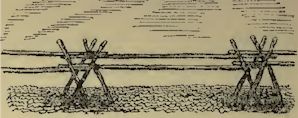 |
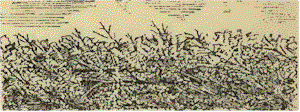 |
| Two-Rail Fence |
Brush Fence |
The brush fence is about as ancient as
the two-pole fence, and has passed away first in our county.
Someone has said that, "According to an unwritten law, a brush
fence must be a rod wide, with no specification as to its
height." In and under the brush fence all sorts of living
creatures, beast, bird, and reptile, have made their homes. In
building or piling a brush fence the small trees along its line
were lopped down, but not entirely severed from the stump, and
made to fall in one direction lengthwise of the fence. Other
trees were added to give it the height and width required. This
was a very effective barrier.
The fence next to be built by our
forefathers was a log fence. This was one of the most
substantial of fences, but was only erected where there was a
great amount of timber at hand. The great logs, generally of
pine, were laid straight, overlapping a little at the ends, on
which were placed horizontally the short cross-pieces, which
upheld the logs next above. It was usually built three logs
high, and formed an almost solid wooden wall. From behind the
log and brush fences, the prowling Indian shot the settler as he
tilled his field, or long watched the lonely cabin before he
surprised its defenseless inmates.
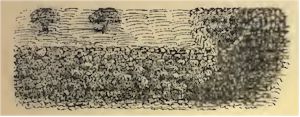
Stone Fence
Where stones were plentiful and timber
and poles scarce, stone walls were built as early as the
seventeenth century. They proved the most enduring and in every
way satisfactory. In spite of their being more or less
frost-flung, they remain a picturesque and sufficient barrier,
and will so remain until they sink beneath the surface of the
ground. Often the stones of the wall were taken from the field,
where it was built, in the course of tillage. There seems almost
to have been a stone age in New England history, when stone was
the material most frequently employed for fence building.
Sometimes a single stone wall can be found stretching away in a
straight line over hill and through valley for miles. In some
localities it would seem as if every field and pasture and
garden were bordered with it. The great amount of stone wall
that remains attests the labor of our ancestors. What bending
and straining of stalwart backs and muscles there must have been
at the building of these walls, which have been the castle of
the squirrel, the weasel and the woodchuck through the
centuries.
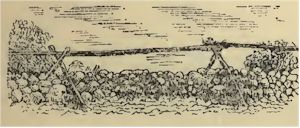
Half High Wall Fence
Where neither stones nor timber were
plenty the half-high wall, surmounted by a rail resting or
crossed stakes driven into the ground, as shown in the
illustration, was early used, and is still common.
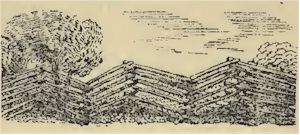
Snake Fence
After these earlier fences came the
snake or Virginia fence, made of rails arranged as shown in the
illustration. This variety of fence is truly American.
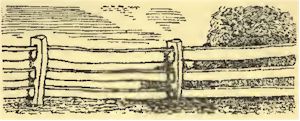
Split Rail Fence
The split-rail fence is also old. Logs,
generally of ash, about nine feet in length, and a foot or more
in diameter, split the entire length into about sixteen equal
parts, formed the rails, which were chamfered at each end. Of
such split sections posts were also made, having holes cut in
them in the proper places to receive the ends of the rails, the
fence being constructed as shown in the illustration. It is to
the credit of Abraham Lincoln that in his early frontier home he
was a skillful rail-splitter.
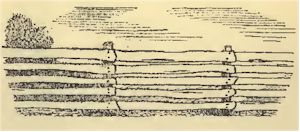
Board Fence
The board fence came into existence with
the advent of saw-mills. The old board fence consisted of wide,
rough-edged boards nailed to posts set in the ground, and was
always an inartistic structure.
On leaving this subject, the countless
disputes, contentions and heartaches of the past arising from
line fences, where slight divergences have created feuds which
have continued for several generations, and the matter of
maintenance of certain portions of fences and building of spite
fences are recalled. They have always been a fruitful source of
disputes and friction between neighbors in the past, but under
more definite laws will probably be less so in the future.
AHGP
Massachusetts

Source: The Essex Antiquarian, Volume I,
Number 3, March 1897

Hosted Free by

Come back Soon!!
Copyright August © 2011 - 2024
AHGP - The American History and Genealogy
Project.
Enjoy the work of our webmasters, provide a link, do not copy their
work.
|

